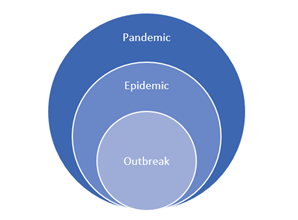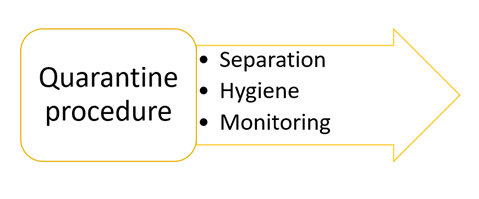What is quarantine?
The word quarantine became a buzzword after the breakdown of the COVID – 19 pandemics. Quarantine word is derived from ‘quarantena’, which is an Italian word. It stands for ‘forty days.’ The quarantine can be defined as a situation under which a person who has arrived from a place exposed to infectious diseases is placed in isolation.
The person kept in isolation may or may not be exposed to the disease or infection. They might be infected and show the symptoms later. Therefore, to protect the interest of the larger population, people are kept in an isolated place.
Summary
- Quarantine stands for the situation in which a person who has arrived from a place that reported significant cases of infectious disease is placed in isolation.
- Quarantine takes place to protect a large population from the spread of viruses or infections.
- Quarantine gained significant attention after the breakout of the COVID-19 pandemic. It involves restricting the movement of a person who came in contact with an infected person or visited an area with the highest number of coronavirus cases.
- People under quarantine should separate themselves, keep a check on their hygiene and monitor themselves.
Frequently Asked Questions
When are people quarantined?
People or the government authority undertakes quarantine, generally in three cases, namely,
- Outbreak – the cases of particular diseases show a sudden and significant rise.
- Epidemic – It is similar to the outbreak, but the spread of disease is prominent in geography.
- Pandemic – When people worldwide are infected with a particular disease, it is termed a pandemic.

Source: Copyright © 2021 Kalkine Media Pty Ltd
What is the difference between quarantine and isolation?
Isolation and quarantine are generally used in a similar situation; however, these terms are used separately as per the situation.
Quarantine term is used for the people exposed to the virus, but symptoms are not seen yet. It is unknown whether the person has a virus or not. In case the person got infected with the virus, then symptoms will be seen within 14 days. Therefore, quarantine in a coronavirus pandemic is 14 days.
On the other hand, isolation is used when a person is tested positive with COVID – 19 and kept in isolation, far from outsiders. If the person is tested positive and does not have symptoms, he will have to remain in isolation until there are negative reports.
What is the procedure of quarantine?

Source: Copyright © 2021 Kalkine Media Pty Ltd
Separation
While in quarantine, a person must have a separate room along with a separate bathroom, preferably. Moreover, the room must be adequately ventilated.
The main goal of the separation is that the person should not come in contact with outsiders. Therefore, a person in quarantine should not leave the room. So, the essential commodities should be made available by the healthcare/ government authorities or the family members.
As per the WHO and other healthcare organisations, the quarantine period in COVID-19 should last for a minimum of 14 days. In case the person develops symptoms, then the period of isolation begins. Isolation will last till the person is tested negative.
There is no evidence that whether animals are infected with coronavirus or not. However, being on the safer side, pets are not allowed with a quarantined person.
Hygiene
A person should maintain hygiene by adhering to the best practices required for the pandemic.
In the case of coronavirus, it is observed that the most common source through which the virus can be transmitted is through hands. Touching the things which the infected person touches can transmit the disease.
Coronavirus attacks the respiratory system. The respiratory viruses enter the human body through the nose, throat or eyes via mucus containing the virus.
To remove the traces, washing hands with soap can be effective. To avoid the spread of the virus through the air, masks are made mandatory. Furthermore, the household waste of the infected person must be disposed of properly.
Monitoring
During quarantine, a person monitors themselves along with the healthcare authority. Development of any symptom listed by the national authorities must be reported. Based on the monitoring, further steps are decided. Moreover, the person can contact their doctor, to check the reason for the symptoms observed.
How quarantine affects the psychology of a person?
Stress is observed to be a common symptom observed amongst quarantined people. Many studies have listed down the adverse psychological outcomes which are associated with quarantine.
- Fear: people have a fear of getting infected especially, females with young children. Few people have a fear of extension of quarantine or getting into the isolation stage.
- Boredom: Loss of contact with society and change in the expected results in frustration. In effect, people get mentally stressed.
- Inadequate supplies and information: People are not generally equipped with all the resources they require while quarantined at a medical facility. Moreover, people do not have access to the information regarding the changing guidelines. This results in stress, anxiety and anger.
- Financial pressure: Due to quarantine, people cannot continue their daily professional; responsibility. It adds to the fear of loss of jobs and financial stability. In many cases, to stay at quarantine canters, people have to make some payment, which further adds pressure on the financial distress.
What is the significance of being quarantined in a Pandemic such as COVID – 19?
In the coronavirus pandemic, quarantine stands for restricting the movement of a person exposed to an infected (COVID – 19) individual. Also, the person's activity is restricted if he had visited an area that has reported a significant number of coronavirus cases.
Quarantine is necessary in case of COVID -19 pandemic because the symptoms develop after 3 – 4 days. During this time interval, infected people can transmit the virus to their community.
While in isolation, the person is monitored in terms of the development of any symptoms. If the development of symptoms is seen, then the spread is confined within the quarantine centre or home.
A 14 – day quarantine is suggested for a person exposed to or is a confirmed COVID-19 case. The decision to discontinue 14 – days quarantine depends on the government authorities and doctors based on the risk of transmission of the virus. In many cases, the quarantine period might be even extended by few weeks.
 Please wait processing your request...
Please wait processing your request...